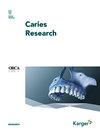西班牙儿童的注意力缺陷多动障碍症状和口腔健康问题。
IF 2.6
2区 医学
Q1 DENTISTRY, ORAL SURGERY & MEDICINE
引用次数: 0
摘要
本研究的目的是在西班牙 6 至 14 岁人口的代表性样本中,探讨注意力缺陷多动障碍(ADHD)症状与口腔健康之间的关系,我们研究了儿童/青少年的一些社会人口和行为决定因素及其家庭环境的作用。采用 "优势与困难问卷 "中的 "自我报告多动/注意力不集中 "分量表来确定是否存在多动症状。口腔健康采用五项指标进行评估:龋齿、拔牙、修复、牙龈出血和牙齿状况不佳(如断裂或错位)。我们使用逻辑回归分析了多动症症状与口腔健康指标之间的关系。结果与没有多动症症状的儿童相比,有多动症症状的儿童患龋齿(完全调整后的几率比:2.16;95% 置信区间:1.66-2.82)、拔牙(1.42;1.09-1.85)、修复(1.47;1.19-1.82)和牙龈出血(1.64;1.11-2.41)的风险更高。当分析对象仅限于中/高社会阶层家庭以及糖摄入量低、口腔卫生行为良好和定期看牙医的儿童时,龋齿风险增加的情况依然存在。我们的研究结果表明,多动症症状与龋病的关系与社会经济水平、致龋饮食、刷牙频率和看牙次数无关。本文章由计算机程序翻译,如有差异,请以英文原文为准。
Symptoms of attention deficit hyperactivity disorder and oral health problems among children in Spain.
INTRODUCTION
The aim of this study was to explore the association between symptoms of attention deficit hyperactivity disorder (ADHD) and oral health in a representative sample of the Spanish population aged 6 to 14 years, we examined the contribution of several sociodemographic and behavioral determinants of children/adolescents and their family environment.
METHODS
A cross-sectional study involving 3,402 subjects aged between 6 and 14 years from the Spanish National Health Survey. The presence of ADHD symptoms was determined using the self-reported hyperactivity/inattention subscale of the Strength and Difficulties Questionnaire. Oral health was assessed using five indicators: caries, extraction, restorations, gingival bleeding, and presence of teeth in poor condition (e.g. broken or misaligned). Logistic regressions were used to examine the association between the presence of ADHD symptoms and oral health indicators. These models were adjusted for sociodemographic factors, lifestyle variables, and oral hygiene behaviors relating to both the children and their parents.
RESULTS
Compared to children without ADHD symptoms, children with ADHD symptoms had a higher risk of caries (fully adjusted odds ratio: 2.16; 95% confidence interval: 1.66-2.82), extraction (1.42; 1.09-1.85), restoration (1.47; 1.19-1.82) and gingival bleeding (1.64; 1.11-2.41). The increased risk of caries was maintained when the analyses were restricted to middle/high social class families and to children with low sugar intake, good oral hygiene behaviors and regular dental visits.
CONCLUSIONS
Children with ADHD symptoms in Spain had worse oral health indicators than those without ADHD symptoms. Our results suggest that the association of ADHD symptoms with caries was independent of socioeconomic level, cariogenic diet, frequency of toothbrushing and dental visits.
求助全文
通过发布文献求助,成功后即可免费获取论文全文。
去求助
来源期刊

Caries Research
医学-牙科与口腔外科
CiteScore
6.30
自引率
7.10%
发文量
34
审稿时长
6-12 weeks
期刊介绍:
''Caries Research'' publishes epidemiological, clinical and laboratory studies in dental caries, erosion and related dental diseases. Some studies build on the considerable advances already made in caries prevention, e.g. through fluoride application. Some aim to improve understanding of the increasingly important problem of dental erosion and the associated tooth wear process. Others monitor the changing pattern of caries in different populations, explore improved methods of diagnosis or evaluate methods of prevention or treatment. The broad coverage of current research has given the journal an international reputation as an indispensable source for both basic scientists and clinicians engaged in understanding, investigating and preventing dental disease.
 求助内容:
求助内容: 应助结果提醒方式:
应助结果提醒方式:


